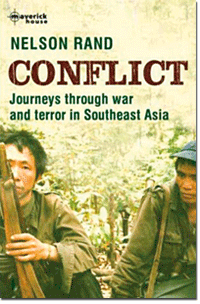
| By DAVID SCOTT MATHIESON | SEPTEMBER, 2009 - VOLUME 17 NO.6 |
A photojournalist’s account of covering regional conflicts fails to rise to the level of drama and tragedy encountered
 |
| Conflict: Journeys through War and Terror in Southeast Asia, by Nelson Rand. Maverick House, 2009. P 250 |
Tim Page was a wild-child who merged Jimi Hendrix with superpower destruction and the suffering of people caught up in what his contemporary Philip Jones Griffiths called “Vietnam Inc.” Page empathized with those around him. Read his excellent autobiography “Page after Page,” and you’ll understand.
Conflict memoirs have a noble place in contemporary reportage. From Kipling to Greene, to the haunting Iraqi War reflections of Dexter Filkins’ “The Forever War,” even the tongue-in-cheek “War Reporting for Cowards” by Chris Ayres, serious journalists have created powerful books about conflict.
Nelson Rand’s “Conflict” is not in this league. Rand decided to leave his studies in Vietnam to “launch his career” as a journalist in 1998 by traveling to Anglong Veng in Cambodia to witness the horrid end run of the Khmer Rouge. Rand writes that while the book “draws heavily on my experiences, the aim is not to tell my story, but the story of these conflicts and the people caught up in them.”
The book is laid out in four chapters of reflections on his trips to Cambodia in the late 1990s, Karen State in Burma during 2000 to 2002, in Laos with the Hmong in 2004, and the conflict in South Thailand in 2008.
Each chapter begins with a few pages on how Rand arrived in each conflict zone, several pages of derivative, pedestrian background to the conflicts, and then a narrative of his personal experiences: finding old photos of Pol Pot, witnessing ambushes by Karen soldiers against the Burmese army, venturing into the Lao jungle to meet the wretched remnants of the Hmong resistance, and on patrol with Thai paramilitaries in Yala Province.
Yet there is no overarching theme to all the encounters. There are good interviews, but the analysis is simplistic and unfulfilling, rather like a chance conversation with a backpacker tourist.
Unfortunately, the book slugs along with very little insight into what fuels these wars and how local people really feel about them. All of the conflicts have been well documented by writers and photographers with more experience and sensitivity than Rand provides.
What seriously cripples the book are some cringe-worthy sentences. “When I’m under fire, I’m far more comfortable shooting a camera than a weapon,” this after a Thai soldier offered him an AK-47 assault rifle to carry on patrol. He talks of “chasing the dragon of combat” and describes a young Karen soldier as “a kind person who would have taken a bullet for me.” This isn’t ordinarily a quality you might expect from someone you’ve just met.
The account of ambushes Rand photographed in Karen State doesn’t ring true. Something feels not quite right about his version of events, as if we’re not being told the full story. Perhaps it’s Rand’s descriptive powers, calling an ambush “a familiar experience that never lost its seductive strangeness. It’s an exhilarating rush sitting in an ambush facing imminent danger and staring down your fears… My main concern was not the mortars and rockets flying overhead, but the lack of light available for taking pictures.”
The book’s nadir is when Rand describes the pictures he could have taken in Laos, but failed to for various reasons: “Most of the pictures I took could only be developed in the darkroom of my mind.”
This doesn’t accord well with the highly professional and lovably loopy conflict photographers I know, who travel to dangerous places precisely so that they can document what is happening. It makes you wonder if Rand traveled to conflict areas for personal thrills or professional purposes.
“Conflict” is basically a book of trite stories told around a bar or the dinner table. It’s a personal blog page in printed form. The book is somewhat useful for showing just how interesting modern Southeast Asia is and how depressing its wars really are, but unfortunately it doesn’t do any of the complex conflicts—or the millions of people suffering and surviving in them—any real justice.
David Scott Mathieson is Burma researcher for Human Rights Watch.